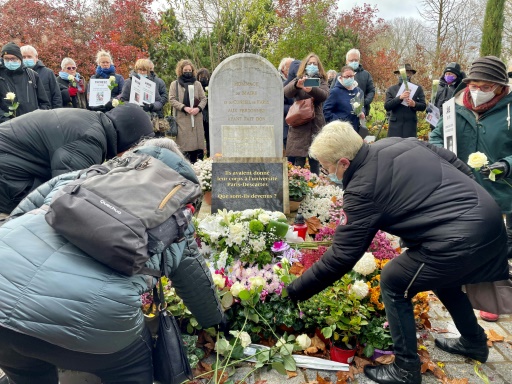
A procession in front of the stele commemorating the people who delivered their bodies to the Université Paris Descartes on November 27, 2021 in Thies Clara Wright
In a French cemetery, on a plaque with chrysanthemums, a black memorial plaque: “They delivered their bodies to the University of Paris Descartes. What happened to them?”
At Thiays cemetery, south of the French capital, families on Saturday paid tribute to loved ones who had donated their bodies to science, with no doubt that their remains would end up at the center of a scandal.
In 2019, a “mass grave” was revealed at the Center for Body Donation at Paris Descartes University, a temple of medicine in France. The investigation that was opened later shed light on the “inactivity” of the officials of the prestigious Parisian institution for several decades.
These discoveries led to four indictments, including the indictment of the University of Paris and the former president of the University of Paris Descartes, for “assault on the integrity of the corpse”.
Two years later, about fifty members of the “Charnier Descartes, Justice et Dignité” (CDJD) congregate for the first time in the cemetery where the stele was erected.
Carol Hughes, 60, told AFP that she “perfectly” remembers the moment she discovered the affair in November 2019: “It was a surprise.”
A teacher, she was leaving for work when she heard on the radio what L’Express had revealed about the “improper conditions” for the preservation of the remains of “thousands of people who have donated their bodies to science”. His mother, Jeanette, was one of them.
Dilapidated places, rotten remains eaten by rats, suspicion of commodification of bodies… Far from what Jeanette had hoped. “Her idea was very simple, because she is a very simple woman, who served something to the end,” says Carol Houghs.
– ‘Say goodbye’ –
Discovering the scandal was “like mourning a second time,” said Beaudoin Afar, president of the CDJD Association, holding a sign showing his father, George, a former boy who became an oil tanker captain, who wanted to “serve someone one last time” by donating his body.
“This sadness has turned into anger. We are here today in this cemetery to show that we know the investigation will continue but that we are united and won’t let go,” he explains. “We would like justice to hear from others.”
Valerie Lenoir, 54, abounds, “I hope justice will be done, a little for us, to rehabilitate them, to restore their dignity, and then to all those who want to give their body to science.”
In this autumn month, it rains on the grave. But Valerie wears sunglasses that hide her cloudy eyes.
“I think about it every day. It’s indescribable,” attacks this resident of the Paris region, whose corpses were presented by his mother and grandfather “out of generosity.”
In most cases, families regret that a ceremony is rarely held when the bodies of the deceased are donated.
So despite the anger expressed, this gathering brings some solace: “It’s a bit like a celebration we didn’t have, a way to say goodbye,” says Valerie’s daughter Laura, as she places a white rose on the grave, in front of the accusation board. black .
In the back, another ancient memorial plaque adorns the obelisk. Written there: “University Paris Descartes salutes those who have donated their bodies for anatomical research and medical science.”

“Music guru. Incurable web practitioner. Thinker. Lifelong zombie junkie. Tv buff. Typical organizer. Evil beer scholar.”






More Stories
A large manufacturing project awaits space in the industrial zone
According to science, here are officially the two most beautiful first names in the world
Green space, 100% pedestrianized: DIX30 reinvents itself